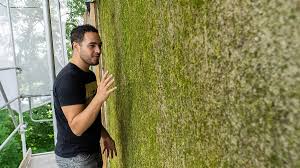Noise Barriers
Sustainable urban planning / Air pollution-CO2 mitigation
Respyre's moss-covered noise barriers combine sound absorption with ecological benefits, reducing noise pollution while improving air quality, supporting biodiversity, and contributing to urban cooling through sustainable design.
Contact
Company Established Year
Info
Available



Looking

Project Status
Looking to expand internationally
Doing business in
Awards
The Noise Barriers by GoRespyré
For innovative integration of greenery in infrastructure
Acoustic Excellence Prize
Recognized for effective noise reduction solutions.
Green Infrastructure Medal,
Honored for contributions to eco-friendly urban design.
Product description
GoRespyré's Noise Barriers are a fusion of functionality and environmental consciousness. Constructed from high-density concrete, these barriers effectively mitigate noise pollution in urban settings. The integration of moss not only enhances the visual appeal but also contributes to air purification and biodiversity. These living barriers are low-maintenance and durable, making them suitable for long-term infrastructure projects. Their design supports ecological balance while addressing the practical needs of noise reduction in densely populated areas.
Key characteristics and environmental benefits
Key Characteristics
-
Constructed using bioreceptive concrete that enables and sustains moss growth.
-
Made with 70% recycled materials, significantly reducing the environmental footprint.
-
Designed for noise reduction, effectively absorbing and blocking urban sound pollution.
-
Engineered for durability and low maintenance, with no irrigation or chemicals required.
-
Modular and scalable, suitable for deployment along highways, railways, and industrial areas.
-
Adds aesthetic value by transforming grey infrastructure into vibrant green walls.
Environmental Benefits
-
Improves air quality by filtering out pollutants and sequestering CO₂ through moss photosynthesis.
-
Contributes to urban cooling via evapotranspiration, reducing heat island effects.
-
Supports biodiversity by creating microhabitats for insects, birds, and small organisms.
-
Enhances climate resilience by reducing surface temperatures and aiding in stormwater management.
-
Promotes circular economy principles by reusing waste concrete in its composition.
About the Company
Ask about Noise Barriers
Hi there! I’m here to help you quickly understand what this green solution is about — without needing to read the full page.
You can ask me things like:
- What problem does it solve?
- How does it help the environment?
- What makes it different?
Let’s explore together!
You can try asking:
Oops, it seems like you're not a member.
Sign up! It's free. You'll be able to read all the articles you like, download PDFs, and get in contact with the respective owners.
Have an account already? Sign in here


